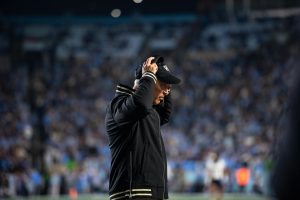Letter to the Editor: A failure of memory and a lack of intention
December 13, 2022
Aug. 28, 2021.
The staff piece outlining the history of movements against sexual violence reeks of failed recollection, not true remembrance. In a sense, the author was trying to remember the gestation of student action against a trend of harm at Wake Forest. In doing so, they landed on Aug. 28, 2021 – around four months later than they should have. In the Old Gold & Black’s attempt to detail the past, they reimagined a wave of students climbing to the quad “in response to an allegation of sexual assault against a Wake Forest student.” In actuality, this was proactive action after a Black student’s return to campus following a closed Title IX case.
Here, I take no position in relation to his guilt but choose to gesture towards their rejection of his innocence. White students cried out for him to show himself, posted Yik Yak’s misidentifying Black men on various parts of campus, and offered rewards to the fraternity men who participated. His name was mentioned with rancor while other white respondents settled in quietly like the one who lived near me. This “protest” (though I hesitate to even use that term to sanitize what transpired) caused Black students to flee out of fear for their safety and largely rubbed out any discussion of the protest facilitated by Black students in the semester before. Irresponsible and shortsighted, in an effort to target a Black respondent, it centered white women’s experiences. It was a truly southern moment at this predominantly white institution (PWI) that gestured backward towards the Reconstruction Era and forward to a movement for and by white constituents of Wake Forest University. The event never should have taken place.
And thus, we arrive in the previous April. “To Whom Do We Cry: A Speak Out on Violence Against Black Women and Girls” took place on Tribble Courtyard on April 30, 2021. I was there. The Black political and joy space boasted chalk for self-expression, a Black Feminist Syllabus for folks to take away, and an atmosphere of fervency and focus on uplifting the least among us. Students spoke about their experiences with Title IX, harassment, rape, and other atrocities and called for community care, action, and response; the attendees were a diverse constituency, but the white Greek community did not show up with megaphones and fury in the manner they would four months later. The Old Gold & Black did not show up at all.
They acknowledged this absence this past spring, sending a reporter to cover “This Bridge Called My Back: A Speak Out on Invisible Labor,” but failed to complete the central tenet of valuable regret–the decision to do better. Repeating mistakes of the past, they used the white-centric timeline of gender equity efforts, failed to ask organizers of Black protest to comment, and declined to mention the controversy of the mob on the quad. This dilution of the findings is the chaser, but the lack of intention was the shot – neither is sitting well.
The article did mention Dr. Shea Kidd-Brown’s focus on diversity, equity, and inclusion along with marginalized distrust of existing resources, but neither concept is applied to the article itself. The OGB could have centered marginalized voices or interviewed students about their hesitancy but instead, they discussed safety concerns about “criminals.” The article perpetuates mythology surrounding perpetrators as benign strangers in the bushes that law and order will contain by discussing policing trends writ large without meaningfully engaging with the conditions of race that produce said dynamic. A paragraph should be dedicated to their proposed solution of more surveillance–an issue that is largely racialized and fails to address prevention in favor of response. In another column, a contributor personally named that she’d been assaulted and deposited in front of the DKE house, but the paper leads with a statement about the issue being not being Greek or non-Greek. The dark basements and off-campus haunts of party culture must have disaffiliated. Would these cameras be crept into the corners of KA or simply existed in university-owned environments that minority students have open access to?
Ultimately, the content reflects not necessarily a lack of interest but really one of intention. I’m troubled by the way Black and brown mistrust is cited as a major issue of resource engagement (with the campus police being named explicitly) but its implications are ignored. I could go on about the absence of a trigger warning or the exclusion of a quote from Taylor McCabe–one of the SAPSA co-chairs and a student present at “To Whom Do We Cry.” Instead, I dwell on the framed date. “How we got here: sexual assault on campus. On Aug. 28, 2021, Wake Forest students protested….” Considering this beginning, where will the erasure of marginalized student efforts end?












